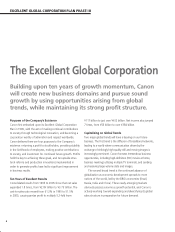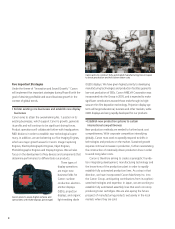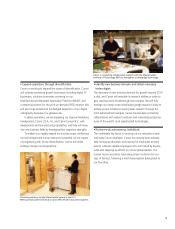Canon 2005 Annual Report Download - page 18
Download and view the complete annual report
Please find page 18 of the 2005 Canon annual report below. You can navigate through the pages in the report by either clicking on the pages listed below, or by using the keyword search tool below to find specific information within the annual report.
16
R&D activities are highly valued at Canon, providing the lifeblood
that feeds Canon’s growth. Canon consistently delivers technological
innovations that support the evolution of business fields.
Research & Development
Canon pays the utmost regard to
research and development as the very
origin of its profit. For that reason, we
dedicate a high proportion of net sales
to these activities. In 2005, R&D expens-
es increased ¥11.2 billion from the
previous fiscal year to ¥286.5 billion,
corresponding to 7.6% of consolidated
net sales. Breaking this down, research
and development expenses for business
machines amounted to ¥117.2 billion, or
40.9% of total R&D expenses, while
expenses for cameras were ¥39.8 billion,
or 13.9% of the total. Investment in
optical and other products was ¥26.9
billion, or 9.4%, and basic R&D that
cannot be allocated by business segment
was ¥102.6 billion, or 35.8%.
Developing Next-Generation
Technologies
Canon intends to aggressively pursue
the development of highly advanced
technologies that can be applied in
new business domains. To this end, we
have established the New Business
Domain Committee, which will explore
new fields to ensure significant growth
from 2010.
Canon’s leading-edge technology
research center at the headquarters in
Tokyo has been completed. Equipped
with a cluster computer system and other
cutting-edge facilities, the center will
conduct basic research and develop
technologies such as DNA chips, OLED
displays, and nanotechnology.
Canon’s R&D organizations often
work in cooperation with research institu-
tions and universities that possess some
of the most sophisticated technological
accomplishment in the world. This helps
us to get a head start on the develop-
ment of advanced technologies.
Furthermore, such collaboration plays an
important role in the speedy establish-
ment of new businesses.
Strengthening Product
Competitiveness
Our five Imaging Engines are a group
of technologies that support Canon
product businesses.
1. Image Capturing Engines
2. Electrophotographic Engines
RESEARCH & DEVELOPMENT
3. Inkjet Engines
4. Photolithographic Engines
5. Display Engines
Each Engine is strengthened by the
fusion of various technologies, and
contributes to extending our overall
technological capacity. As the sources of
our competitive advantage, Canon
continually cultivates these Engines and
focuses on creating new Engines for the
next generation. Efforts to upgrade key
components and key devices improve
the competitiveness of our products. An
exemplary result of this process is
Canon’s CMOS sensors, developed and
manufactured entirely in-house.
Renowned for their high resolution, low
power consumption and noise reduc-
tion, Canon’s CMOS sensors work with
imaging engines to produce highly
detailed photos with no false colors.
Canon is making significant progress
in terms of bolstering shared platform
technologies company-wide through its
high-precision color management
system. All Canon input/output prod-
ucts, from digital cameras, camcorders
and scanners to home-use printers and
large-format printers, share the unified
color management scheme as one of
the high-level imaging technologies.
This superiority and compatibility of
Canon’s proprietary technology con-
tributes to the competitive edge of
Canon’s products.
Canon has made remarkable reforms
to its new product development process
through the introduction of 3D-CAD
Canon’s newly completed leading-edge
technology research center in Japan
Canon established DNA chip production method
using its Bubble Jet printing technology
























